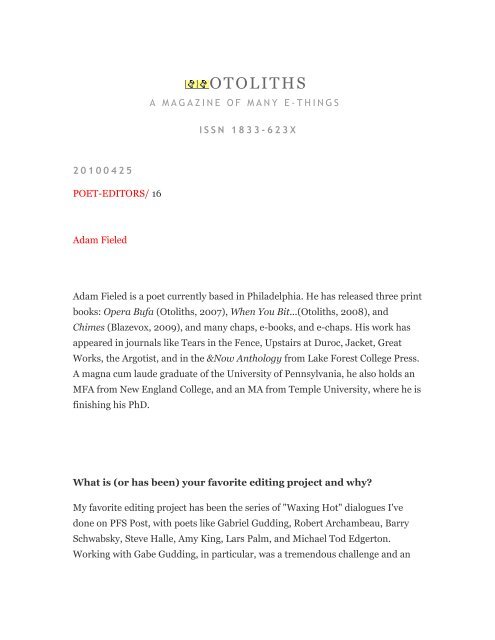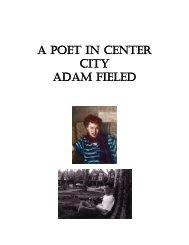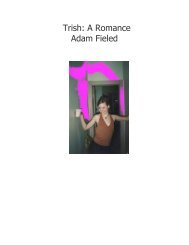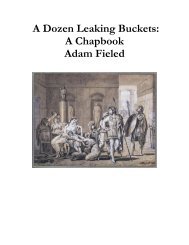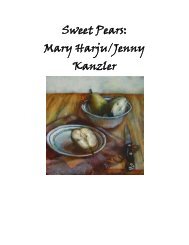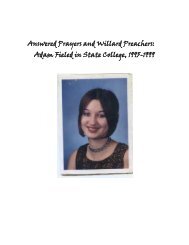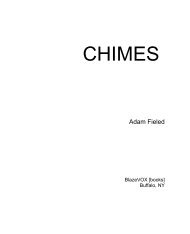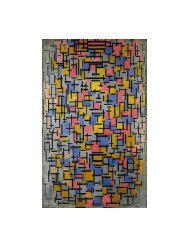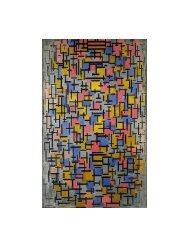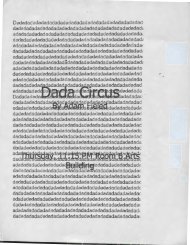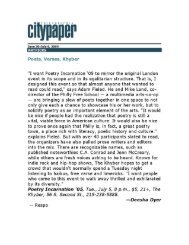FROM OTOLITHS 16: Editor Interview
A pdf from Otoliths Issue # 16: Ed. Interview with Adam Fieled and his article about the Philly Free School
A pdf from Otoliths Issue # 16: Ed. Interview with Adam Fieled and his article about the Philly Free School
Create successful ePaper yourself
Turn your PDF publications into a flip-book with our unique Google optimized e-Paper software.
2 0 1 0 0 4 2 5<br />
POET-EDITORS/ <strong>16</strong><br />
Adam Fieled<br />
<strong>OTOLITHS</strong><br />
A M A G A Z I N E O F M A N Y E - T H I N G S<br />
I S S N 1 8 3 3 - 6 2 3 X<br />
Adam Fieled is a poet currently based in Philadelphia. He has released three print<br />
books: Opera Bufa (Otoliths, 2007), When You Bit...(Otoliths, 2008), and<br />
Chimes (Blazevox, 2009), and many chaps, e-books, and e-chaps. His work has<br />
appeared in journals like Tears in the Fence, Upstairs at Duroc, Jacket, Great<br />
Works, the Argotist, and in the &Now Anthology from Lake Forest College Press.<br />
A magna cum laude graduate of the University of Pennsylvania, he also holds an<br />
MFA from New England College, and an MA from Temple University, where he is<br />
finishing his PhD.<br />
What is (or has been) your favorite editing project and why?<br />
My favorite editing project has been the series of "Waxing Hot" dialogues I've<br />
done on PFS Post, with poets like Gabriel Gudding, Robert Archambeau, Barry<br />
Schwabsky, Steve Halle, Amy King, Lars Palm, and Michael Tod Edgerton.<br />
Working with Gabe Gudding, in particular, was a tremendous challenge and an
honor, and several of this series have been re-published in the UK print journal<br />
Tears in the Fence.<br />
On the Possibilities of Multi-Media Readings<br />
In 2004 and 2005, a group of young artists who called themselves the Philly Free<br />
School staged a series of performances at the Highwire Gallery, in the now-<br />
demolished Gilbert Building on Cherry Street, Philadelphia. The stated goal of<br />
these performances was “multi-media”: as such, they involved poetry, music,<br />
fiction, films, and different hybrid/mutant versions of these. What I want to<br />
address, specifically, is the poetry aspect of these performances. These seem<br />
relevant to me now because multi-media presentations of poetry are, to many,<br />
significantly more interesting than standard poetry readings, which are (I would<br />
argue) an impoverished form of public expression. What constitutes the<br />
impoverishment of poetry readings as public art events? Let’s put the question in<br />
different terms: what does a poetry reading offer an average audience?<br />
An audience at a standard poetry reading is offered an anti-spectacle— a single<br />
man or woman, reading from sheets or a book, often looking down at this book<br />
while intermittently gazing up at his or her audience. Why look at something or<br />
someone static, and (for the most part) inexpressive? This is the first level of<br />
impoverishment. Then, as to the contents of poems read in a public context: are<br />
most poems compelling enough, as works of literature, to merit public airing?<br />
The truth is that most serious poems do not read that well out loud— poems<br />
(good ones) contain enormous amounts of compressed data, which necessitates<br />
slow, ocular engagement. Lines that need to be read three or four times to be<br />
properly processed pass with such rapidity, in a reading context, that they might
as well be Greek as English. Moreover, attendees have two options— to make an<br />
earnest attempt to understand things instantly, or to drift off into reverie. The<br />
latter has consistently been my choice (and I have, fortunately or unfortunately,<br />
sat through dozens of readings).<br />
But the Philly Free School artists (of which I was one) started from the<br />
presupposition that poetry could be mixed with Artaud; that public poetry is, in<br />
fact, better as a side-dish than as a main course; and that the possibilities of<br />
“spectacles” were (and remain) more exciting than more conventional poetry<br />
contexts. As such, the Philly Free School shows (which were well-attended but<br />
received little media coverage) presented, in general, little in the way of<br />
conventional poetry performances; poetry was mixed with video and music to<br />
create novel effects. I was proud to contribute to these performances, because<br />
they had not only young energies but principles behind them. While I would not<br />
deny that results were mixed (some ideas came off, some did not), I have yet to<br />
see another concentrated attempt to make poetry multi-media in a public forum.<br />
We were using artful language as texture, the way a painter might use<br />
brushstrokes, and an inquiry into this usage (language-as-texture) revealed<br />
untapped possibilities as regards making poetry interesting to audiences, who<br />
may or may not find poetry interesting to begin with.<br />
When language is used as texture, as a constituent part of a spectacle that also<br />
includes sound and images, the audience (ideally) feels itself immersed or<br />
engulfed in a dynamic collage; as such, this kind of performance is an extension<br />
of the Modernist ethos. Fractured things can be more compelling than wholes;<br />
this was one tenet that motivated Pound, Eliot, and the rest. For an audience,<br />
sitting in a darkened room (and the Highwire offered two main spaces, a<br />
conventional gallery space and a warehouse space), this sense of brokenness<br />
could be interpreted many ways, but the essential thing for us was to present<br />
something that was dynamic, rather than static. The most elaborate of these<br />
presentations involved music, images, and poetry at once; while it would be<br />
reasonable to question whether the total effect was bombastic or not, the<br />
responses we received encouraged us to believe that what we were doing was
significantly more exciting than an average poetry performance. Live poetry, I<br />
would argue, only works as texture to begin with; it is in the mix of things that<br />
live poetry comes alive. In the specific performances that I was personally<br />
involved with, I did, in fact, read entire poems; if I had it to do over again, I<br />
would not. It would have been substantially more appropriate to read fragments<br />
or even to improvise. The video collages were put together from foreign movies,<br />
Internet, music video, and photography bits. The musical elements alone were<br />
entirely improvised. Although I am proud of what the Philly Free School<br />
accomplished, it was merely a beginning. Thinking about it now, we could have<br />
been much more rigorous. Our ideas of spectacle were naïve, and needed<br />
development.<br />
What would a completely successful poetry spectacle, in the Artaudian sense,<br />
look like? Artaud, of course, became famous for his idea/ideal of the Theater of<br />
Cruelty; a spectacle that confronts an audience with its own mortality, in an<br />
unflinching, persistent way. What kind of poetry fragments could add, textually,<br />
to such a spectacle? It seems to me that the poetry would have to be written<br />
specifically in conjunction with, specifically for, the music and the images. They<br />
would have to function, in other words, dramatically, as carriers of a certain kind<br />
of drama, just as dialogue in a theater production does. What can poetry<br />
contribute that mere dialogue cannot? Poetry has in its arsenal a capacity for<br />
incantatory power that dialogue does not; an ability to build, to create rhythms,<br />
melodies, and cadences that dialogue cannot. Anaphora is one method by which<br />
this kind of fragment could work; rhyme is another. This is texture that creates<br />
stimulation; with other elements, the potentiality for genuine spectacle, cohesive<br />
spectacle (rather than naïve, haphazard spectacle) arises. As to what the spectacle<br />
addresses, there is no real limitation, other than the impulse to compel attention,<br />
hold it, and overwhelm at once. Certainly the apocalyptic conflicts in the Middle<br />
East, our flagging domestic economy, and the status of the environment are all<br />
fertile (pardon my irony) ground.<br />
Then, there are things standing in the way of this kind of spectacle: time and<br />
budgets are big ones. Many poets just skirt insolvency; serious spectacle
(unfortunately) often involves serious funds. The Philly Free School were lucky<br />
with this, more so than we realized; the Highwire let us use the space for free<br />
(though they took a cut of the door). But to come up with ample space, time, and<br />
funds is a real challenge, which cannot be solved overnight. It may come down to<br />
a collective, like the Philly Free School, to make this happen, if it does ever<br />
happen. To my mind, it would be a tragedy if it does not. There are, in general,<br />
too few poetry readings that have any capacity to stimulate, and too many that<br />
wind up being “snooze-fests.” The irony, for one working in an experimental<br />
context, is that avant-garde poetry readings tend to be even more boring than<br />
mainstream ones— abstruse poetry out loud, which shuns narrative, is more<br />
difficult to follow, and often registers as little better than gibberish. But I will<br />
simply say, for myself, that the desire to create a genuine spectacle with poetry<br />
has not perished, and I hope other kindred spirits are “waiting in the wings.”<br />
Next Poet-<strong>Editor</strong>, Thomas Fink<br />
Back to Poet-<strong>Editor</strong> index<br />
previous page contents next page<br />
POSTED BY MARK YOUNG AT 4:39 PM<br />
0 C O M M E N T S :<br />
POST A COMMENT<br />


